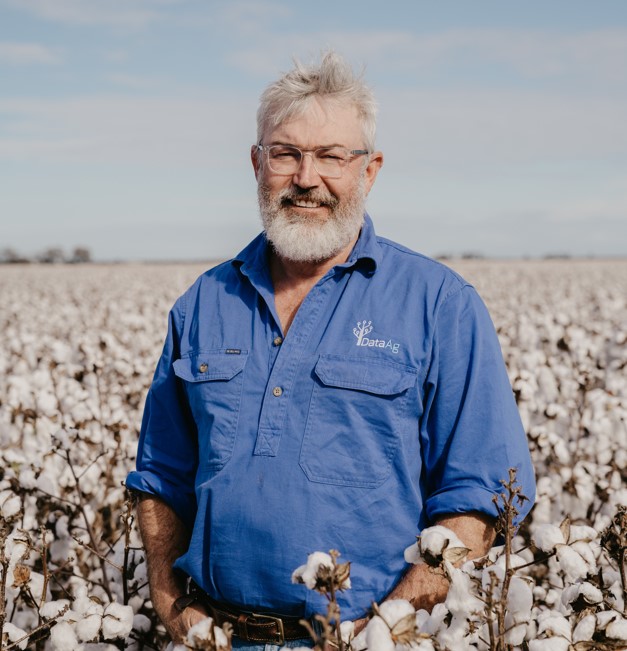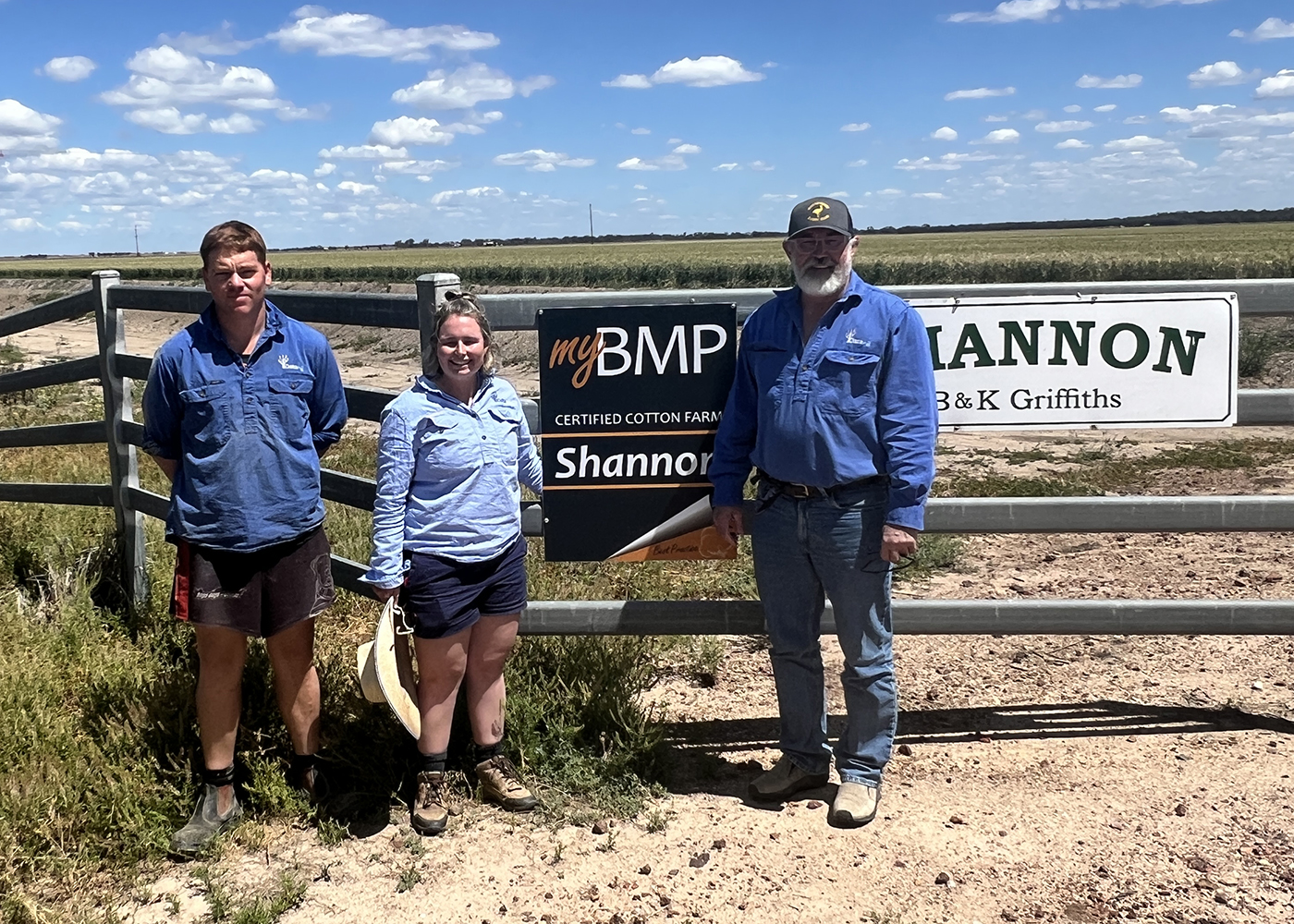Trying season at Gundy

Goondiwindi cotton grower Brendan Griffiths has been an agronomist for 35 years and is a former university lecturer. He described last season as the most trying they’ve had in the past decade. Photos: Supplied
Recent rain has delayed planting for some cotton growers in the Macintyre valley, including Brendan Griffiths who faces a busy couple of weeks.
“We’re just about to harvest 220 hectares of wheat and about 100 hectares of faba beans, and we’re about to plant about 220 or 230 hectares of cotton,” he said.
“The faba beans are okay ... and given the rain that we’ve had for winter, the wheat actually looks pretty good. We’re not going to win a crop competition with it, but it’s done the job.”
Mr Griffiths and his wife Kristina farm about 600ha on the NSW side of the Queensland border, across the Macintyre River from Goondiwindi.
Their property, Shannon, has 400ha set up for irrigation and produces winter cereal crops of wheat and barley, grain legume crops such as faba beans, chickpeas and mungbeans, and cotton.
There’s no standard rotation, with crop choice usually based on water availability
“In the drought we were mostly on a wheat, mungbean rotation,” he said.
“When we’ve got good access to water we are more heavy on cotton.”
An agronomist for 35 years, Mr Griffiths has operated a consulting business – rebranded DATA Ag in 2020 – for about 25 years, and bought Shannon almost a decade ago.
At the time he was also an academic, lecturing in agronomy, soil science and cotton production at the University of New England.
“I come from a farming family on the Darling Downs and I was always going to go back farming,” he said.
“It was just a matter of when.”
Mr Griffiths said the best way to describe 2023-24 was “testing”.
Hail during the season took the shine off the cotton – even though the crop was insured – and more than 180mm of rain in April delayed picking, affecting quality and turning the fields into a mess.
Yields averaged almost 11 bales to the hectare and colour downgrades resulted in a $50 per bale penalty.
“It’s the most trying season we’ve had,” he said.
“It’s not like we were grinding away all season. It’s just the results weren’t quite as good last year as they had been for the past few years before that. We had a few pretty trying years in the drought years with no water, learning to survive on not too much, which we did, and then once the drought broke, we enjoyed a couple of pretty good years.”
After picking, Mr Griffiths decided the best way to take advantage of the soil moisture was to flatten the beds out and plant Borlaug 100 wheat, which looks like yielding 3-4 tonnes per hectare.
Fortunately, the winter crops haven’t affected ground preparation for the coming cotton crop.
Most of the area intended for cotton has been long fallowed after a cotton crop two years ago.
“Conditions for planting don’t get much better, actually, the soil’s in really good condition,” he said.
“We’re going to plant some dryland cotton this year as well into last year’s standing wheat stubble; it’s got a really full profile and things are good.”
About 300kg/ha of nitrogen was split across three applications and 40kg/ha of potassium and about 25kg/ha of phosphorus was applied in late July and early August on flat ground using a tyne fertiliser rig before hilling up.
Using an 8m John Deere MaxEmerge twin disc opener with precision planting e-sets for metering, placement and monitoring, the 100ha of irrigated cotton will be planted at 13 seeds to the metre on 1m rows and the 80ha of dryland cotton at nine seeds to the metre double skip.
If more water becomes available in the next month or so, another 50ha that was in cotton last year will also be double skip planted.
The preferred variety is Sicot 606B3F which yields well in the loamy grey alluvial soils, averaging 12 ½ bales per hectare. Cotton modules are sent to Carrington Cotton, Kurumbul, for ginning.
The residual herbicide metolachlor is applied behind the planter to manage barnyard grass and feathertop Rhodes grass, followed in-crop by Roundup and selective herbicides such as clethodim or haloxyfop for peach vine and bladder ketmia.
There will also be one tillage operation in-crop to clear furrows and make sure irrigation is even throughout the season.
Mr Griffiths has pre-sold two-thirds of the next crop for just over $600/bale, plus a likely $30/bale for seed, which he thought was pretty good.

Alex Henderson (from left), Grace Griffiths and Brendan Griffiths at Shannon which is among the almost 550 cotton farms that are fully myBMP certified this year.
Sustainability is important for both the farm and his agronomy business, so Shannon is Better Cotton Initiative and myBMP accredited, despite being a smaller scale operation.
Mr Griffiths is also conscious of the farm’s location in an environmentally sensitive area not far from the town of Goondiwindi, taking care to minimise the use of chemicals such as pesticides.
Rainfall at Shannon is summer dominant, with an annual average of about 620mm, although it has varied from 200mm in 2019 to 940mm in 2021.
Crops are irrigated using a siphon and flood furrow irrigation system that draws from water stored in an above ground dam and a lagoon with more than 2km of frontage to the Macintyre River. Storage capacity totals 2800 megalitres of water which is sourced from river allocation and overland flows.
Mr Griffiths said they had 900 megalitres of water in storage that was left over from last year’s crops and the big rain in April. Budgeting 9 megalitres per hectare, it should be enough for the fully irrigated portion.
It has been almost 2 ½ years since they were able to pump any supplementary water from high flows in the Macintyre.
